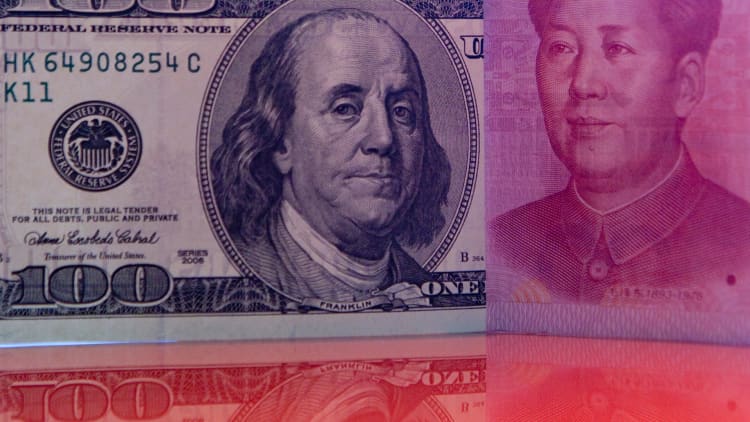Goldman Sachs no longer believes the world's two largest economies will be able to resolve their long-running trade dispute before the U.S. presidential election next year.
It comes shortly after the U.S. officially designated China as a "currency manipulator," amid rapidly intensifying tensions between the two economic giants.
On Monday, the U.S. Treasury accused Beijing of deliberately influencing the exchange rate between the yuan and the U.S. dollar to gain an "unfair competitive advantage in international trade."
The announcement followed a sharp drop in the yuan against the dollar, with the Chinese currency breaching the 7-per-dollar level for the first time since 2008.

Late last week, China promised to fight back after President Donald Trump vowed to impose 10% tariffs on $300 billion worth of Chinese imports.
Analysts at Goldman Sachs, led by Chief Economist Jan Hatzius, said in a research note published late Monday that they had anticipated this move.
"News since President Trump's tariff announcement last Thursday indicates that U.S. and Chinese policymakers are taking a harder line, and we no longer expect a trade deal before the 2020 election."
'A trade deal now looks far off'
In targeting the roughly $300 billion worth of Chinese goods that had not already been targeted by American levies, the U.S. president overruled the adamant objections of nearly his entire trade team, according to a report published by The Wall Street Journal on Sunday, citing people familiar with the matter.
The U.S. is set to impose the charges against Beijing from September 1.
"While we had previously assumed that President Trump would see making a deal as more advantageous to his 2020 re-election prospects, we are now less confident that this is his view," analysts at Goldman Sachs said.
The investment bank added China's decision to suspend purchases of U.S. agricultural goods and its decision to allow the yuan to breach the psychologically-important level of 7-per-dollar "added up to a swift and meaningful response" to Trump's latest tariff threat.
Citing reports that Chinese policymakers are increasingly inclined not to make major concessions and instead are prepared to wait until after the 2020 U.S. presidential election to resolve the dispute if necessary, Goldman said "a trade deal now looks far off."
Since the trade war started last year, Washington has imposed 25% tariffs on $250 billion worth of U.S. imports from China. Beijing retaliated by slapping elevated levies on billions of dollars of American products that it buys.
In recent months, however, tensions between the two countries have extended beyond trade and into areas such as technology and security. In particular, the U.S. placed Huawei on a blacklist which made it more difficult for the Chinese tech giant to do business with American companies.
Interest rates
Analysts at Goldman Sachs also updated their interest rate forecasts for the U.S. central bank over the coming months.
Interest rate futures show market participants see an almost 40% chance the Federal Reserve will lower borrowing costs by half-a-percentage-point next month, up from less than 2% on Friday and 30% earlier Monday.
Goldman Sachs said the Fed had been "increasingly responsive" this year to trade war threats, bond market expectations and global growth concerns.
"In light of growing trade policy risks, market expectations for much deeper rate cuts, and an increase in global risk related to the possibility of a no-deal Brexit, we now expect a third 25bp (basis point) rate cut in October, for a total of 75bp of cuts," Hatzius said.
Analysts at the bank said there was a 75% chance of a quarter-point rate cut in September, a 15% chance of a 50 basis point cut and a 10% chance of no cut. In October, they forecast a 50% likelihood of a 25 basis point cut, a 10% chance of a 50 basis point cut and a 40% chance of no cut.
"By the December meeting, we think inflation numbers running at roughly 2% will lead the Fed to stop cutting," the bank said.
— CNBC's Yen Nee Lee contributed to this report.


